Radon Standards of Practice
On this page:
Note: Federal participation in the development and use of voluntary consensus standards, and in conformity assessment activities, is governed by the National Technology Transfer and Advancement Act (1995), and Circular A-119 (2016, 1998) issued by the Office of Management and Budget, Executive Office of the President. Since about 2012, EPA has been actively participating in the radon industry led ANSI/AARST voluntary consensus-based standards process. As a general principle, the Federal government’s reliance on privately developed voluntary consensus based standards is to be preferred over the Federal government developing such standards. For more information, please visit "Guidance on the Use of Voluntary Consensus Standards for State Indoor Radon Grant Recipients."
Current Radon Standards of Practice
The following Radon Standards of Practice may be viewed for free and PDF copies can be purchased from the Indoor Environments AssociationTM (AARST) webpage. PDF copies can also be purchased from the American National Standards Institute store. To view the standards, please click on the appropriate links below
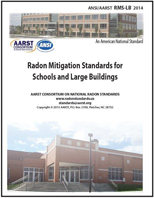
Soil Gas Mitigation Standards for Existing Multifamily, School, Commercial and Mixed-Use Buildings (ANSI/AARST SGM-MFLB-2023)
This standard of practice specifies minimum requirements for methods that mitigate risks to occupants posed by the presence of radon gas and chemical vapors or gas in existing multifamily, school, commercial and mixed-use buildings.
SGM-MFLB consolidates radon mitigation standard published as ANSI/AARST RMS-MF (rev. 12/20) and ANSI/AARST RMS-LB (rev. 12/20) into a single publication and is now harmonized for interactive use with ANSI/AARST SGM-SF (Soil Gas Mitigation in Existing Homes).
SGM-MFLB provides only:
- content that is in addition to requirements already rendered in SGM-SF
- content not normally associated with mitigation of homes.
** While recommended for immediate use, the effective date for compliance with this standard is December 1st, 2023.
Prior Version: RMS-LB-2018-1220 | RMS-MF-2018-1220
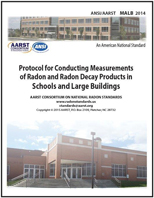
Protocol for Conducting Measurements of Radon and Radon Decay Products in Multifamily, School, Commercial and Mixed-Use Buildings (ANSI/AARST MA-MFLB-2023)
This standard of practice specifies procedures and minimum requirements when measuring radon concentrations in shared structures, or portions of shared structures used for residential, non-residential or mixed-use purposes to determine if radon mitigation is necessary to protect current and future occupants.
MA-MFLB consolidates ANSI/AARST MAMF (rev. 1/21) and ANSI/AARST MALB (rev. 1/21) into a single publication.
** While recommended for immediate use, the effective date for compliance with this standard is December 1st, 2023.Prior Version: MALB-2014-0121 | MAMF-2017-0121
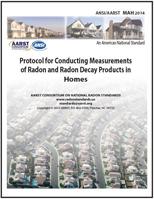
Protocol for Conducting Measurements of Radon and Radon Decay Products in Homes (ANSI/AARST MAH-2023)
This standard of practice specifies procedures and minimum requirements for measuring radon concentrations in single-family residences to determine if radon mitigation is necessary to protect current and future occupants. This standard applies to homeowners, professionals and any other party seeking to determine if radon mitigation is necessary for real estate or non-real estate purposes. Sections 1-7 are directed at anyone conducting radon tests. Additional requirements in Sections 8-9 are directed at those conducting radon tests in association with professional services.
Updates for 2023: Improvements continue with improved clarity for:
- Planning tests that include testing multiple locations in a home
- Test durations when closed-building conditions did not begin 12 hours before the test
- How to handle test results that disagree
- Professional requirements for qualification, onsite documentation, and reporting.
** While recommended for immediate use, the effective date for compliance with this standard is December 1st, 2023.
Prior Version: MAH-2019
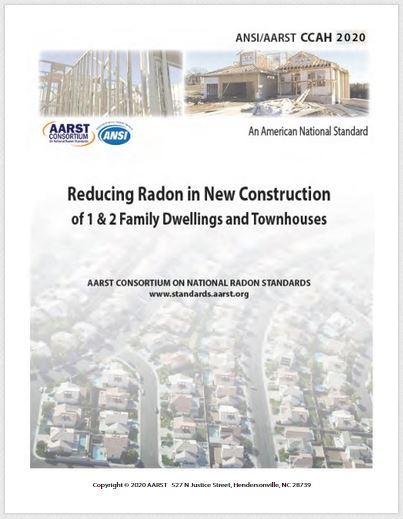
Reducing Radon in New Construction of 1 & 2 Family Dwellings and Townhouses – Rev. 5/23 (ANSI/AARST CCAH-2020-0523)
This standard provides minimum requirements for the rough-in of radon control system components in new dwelling units under construction. CCAH also includes minimum requirements for verifying if radon concentrations are below the national action level and, if required, activation of radon control systems.
Updates for 2023 – Section 801.1 improves upon practical application of initial radon testing after a home is constructed and Appendix B provides definition for qualities associated with acceptable certification programs.
** While recommended for immediate use, the effective date for compliance with this standard is December 1st, 2023.
Prior Version: CCAH-2020
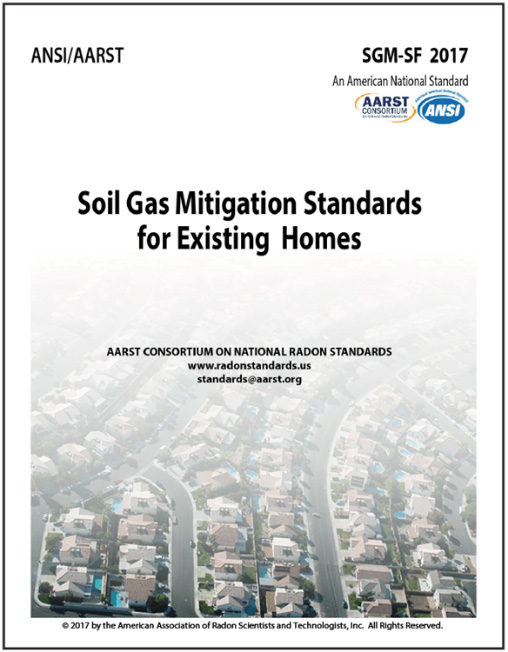
Soil Gas Mitigation Standards for Existing Homes(ANSI/AARST SGM-SF-2023)
This standard specifies practices, minimum requirements and, general guidance for reducing soil gas entry into existing homes in order to mitigate occupant exposures to certain hazardous soil gases, including radon gas, chemical vapors and other hazardous gases.
SGM-SF is now harmonized for interactive use with ANSI/AARST SGM-MFLB (Soil Gas Mitigation in Existing Multifamily, School, Commercial and Mixed-Use Buildings).
** While recommended for immediate use, the effective date for compliance with this standard is December 1st, 2023.
Prior Version: SGM-SF-2017-1220
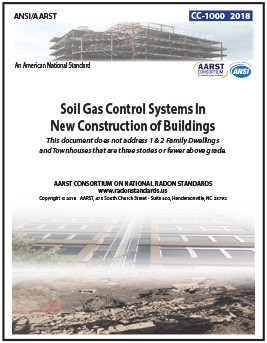
Soil Gas Control Systems in New Construction of Multifamily, School, Commercial and Mixed-Use Buildings – Rev. 5/23(ANSI/AARST CC-1000-2018-0523)
The provisions in this standard provide prescriptive minimum requirements for the construction of any building intended for human occupancy, except for 1 and 2 family dwellings, in order to reduce occupant exposure to radon and other hazardous soil gases. This standard addresses construction of buildings that include, among others, the use of a building or structure, or a portion thereof for multifamily or congregate residential occupancies, educational occupancies, and commercial occupancies.
Updates for 2023
This standard of practice was first published in 2017 and experience since that time was considered in many updates made. The title of the standard was changed for clarity and improvements include:
- Inspections cited during various stages of construction are required rather than optional
- Clarity on qualified professionals needed to implement diagnostic events and effective designs
- Clarity on sealing and soil gas retarder products and installation for completing an air barrier between soil and indoor air
- Integration of existing and improved vapor intrusion design features into sections where items apply.
** While recommended for immediate use, the effective date for compliance with this standard is December 1st, 2023.
Prior Version: CC-1000-2018

Performance Specifications for Instrumentation Systems Designed to Measure Radon Gas in Air (ANSI/AARST MS-PC-2022)
This standard specifies minimum performance criteria and testing procedures for instruments designed to quantify the concentration of radon-222 gas in air. These criteria are applicable to the wide variety of devices used for indoor radon measurements, primarily in residential environments or buildings not associated with the possession or handling of radioactive materials. Also included is a description of documentation necessary for compliance with this standard.
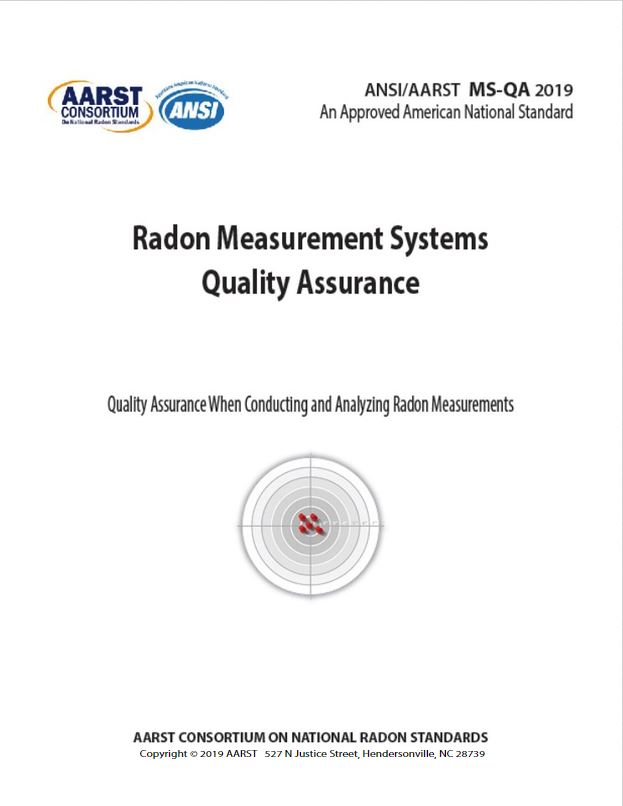
Radon Measurement Systems Quality Assurance(ANSI/AARST MS-QA-2023)
This standard of practice specifies minimum requirements for quality systems designed to quantify the concentration of 222 Rn gas in air by qualified professionals (QPs) and laboratories, whose data are intended to be used to determine the need for, or success of, radon mitigation.
Updates for 2023 include clarity on warning and control limits for less than 2 pCi/L (75 Bq/m 3 ) and harmonization with ANSI/AARST MS-PC on several definitions.
** While recommended for immediate use, the effective date for compliance with this standard is December 1st, 2023.
Prior Version: MS-QA-2019
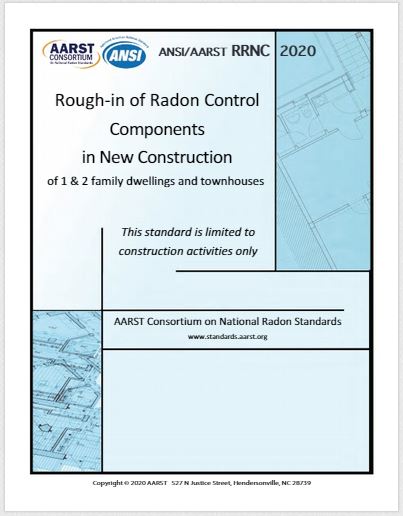
Rough-in of Radon Control Components in New Construction of 1 & 2 family dwellings and townhouses – Rev. 10/22 (ANSI/AARST RRNC-2020-1022)
This standard provides minimum requirements for the rough-in of radon control system components in new dwelling units under construction. This standard is harmonized with ANSI/AARST CCAH, which additionally addresses activation of radon control systems, if required.
Updates for 2023 – This 10/22 revision to RRNC adds a requirement for radon testing after construction is complete.
** While recommended for immediate use, the effective date for compliance with this standard is December 1st, 2023.
Prior Version: RRNC-2020
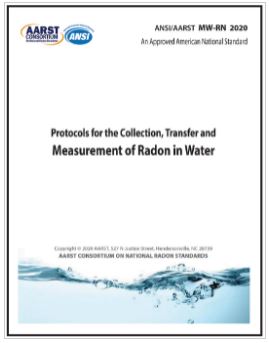
Protocol for the Collection, Transfer and Measurement of Radon in Water (ANSI/AARST MW-RN-2020)
This standard of practice contains minimum requirements and guidance for measuring radon in water that enters a building through groundwater supplies for determining if mitigation is necessary to protect current and future occupants of dwellings and other buildings. This standard includes procedures for the collection and transport of water samples, as well as protocols for the quantitative transfer of the sample to a measurement device to determine radon concentrations in water.
Archived Radon Standards of Practice for Reference
- Protocols for Radon and Radon Decay Product Measurements in Homes (EPA 402-R-92-003, May 1993)
- Radon Reduction Techniques for Existing Detached Houses: Technical Guidance (Third Edition) for Active Soil Depressurization Systems (TXT) (EPA 625/R-93-011, October 1993)
- Radon Measurement in Schools (Revised Edition - Second Printing)
- Model Standards and Techniques for Control of Radon in New Residential Buildings (EPA 402-R-94-009, March 1994)
- Standard Practice for Radon Mitigation Systems in Existing Low-Rise Residential Buildings
